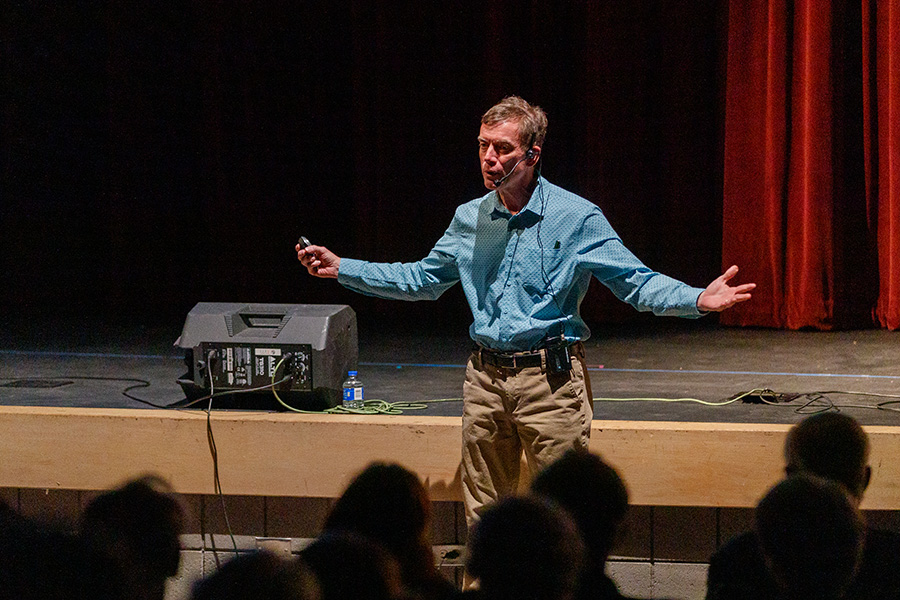
Jeffrey Hall, Ph.D., Executive Director of Lowell Observatory, presented the lecture “Telescopes Around [And Out Of] This World” at the Phillip England Center for Performing Arts in Camp Verde on Sunday, March 5.
Jane Whitmire, president of PECPAF, preceded the lecture with a piano performance.
Hall opened his presentation by showing the audience an image taken by the James Webb Space Telescope. He described how the blobs of light seen in the image result from gravitational lensing, which makes images repeat and reveal different episodes in time.
Hall explained that Galileo Galilei’s 17th century telescopes were refracting telescopes that used lenses to bring light to a focus. This is in contrast to most modern research telescopes, which use mirrors rather than lenses to focus light.
A telescope’s light collecting ability depends on its aperture. The bigger the aperture, the more detail the telescope can resolve.
The Lowell Discovery Telescope, as Hall outlined, is representative of a modern research telescope. Its primary mirror is 170 inches in diameter and four inches thick, and its secondary mirror is 56 inches in diameter. The total weight of the telescope is 135 tons. It stands seven stories tall and cost $53 million to construct.
The mirror is coated in reflective aluminum and must be recoated every five to six years, a process that the observatory typically undertakes during the monsoon. Hall described the process of moving the mirror with a crane and noted that observatory staff are always hoping they don’t drop it on the cement floor. The mirror alone cost $7 million and took seven years to build.
Hall then turned to describing other types of telescopes, such as the atmospheric Cherenkov-type telescopes made of small segments of mirrors, which are used to detect high-energy gamma ray events. Solar telescopes are used to observe the sun and obtain detailed images of sunspots. Chile is home to the Very Large Telescope, located in the Atacama Desert. Hall shared that there is also an Extremely Large Telescope and a conceptual design for an Overwhelmingly Large Telescope.
Hall said that he believes the high Chilean desert is the best site on earth for observing the night sky due to its clear and dry climate. Not a single plant grows there. He shared a photograph he took in the Atacama and juxtaposed it with an image from Mars. The two were indistinguishable.
Turning to space-based telescopes, Hall discussed the Hubble Space Telescope, which revolutionized our understanding of the universe and is now being superseded by the James Webb Space Telescope, launched in 2021. When Hall compared images of the same field of view taken by the two telescopes side by side, the Webb image was much clearer and more detailed.
The New Horizons space probe, launched in 2006, is equipped with a telescope that took a decade to reach Pluto. Hall jokingly stated that it sent out data equivalent to one tweet per second. An image from New Horizons shows that Pluto has 11,000-foot-tall mountains, large flat plains that suggest a young terrain and a thin atmosphere filled with haze.
Many space-based telescopes have long since exceeded their projected lifespans and are still functioning.
Hall concluded by discussing the importance of dark skies for space observation. “Preserving the quality of the night sky is becoming increasingly important,” Hall said. Arizona has six dark sky-certified communities, including Camp Verde.
Lowell Observatory will be opening their Astronomy Discovery Center in 2024. The next PECPAF event will take place at 3 p.m. on April 30, and will feature a performance by the Meadowlark Ensemble.